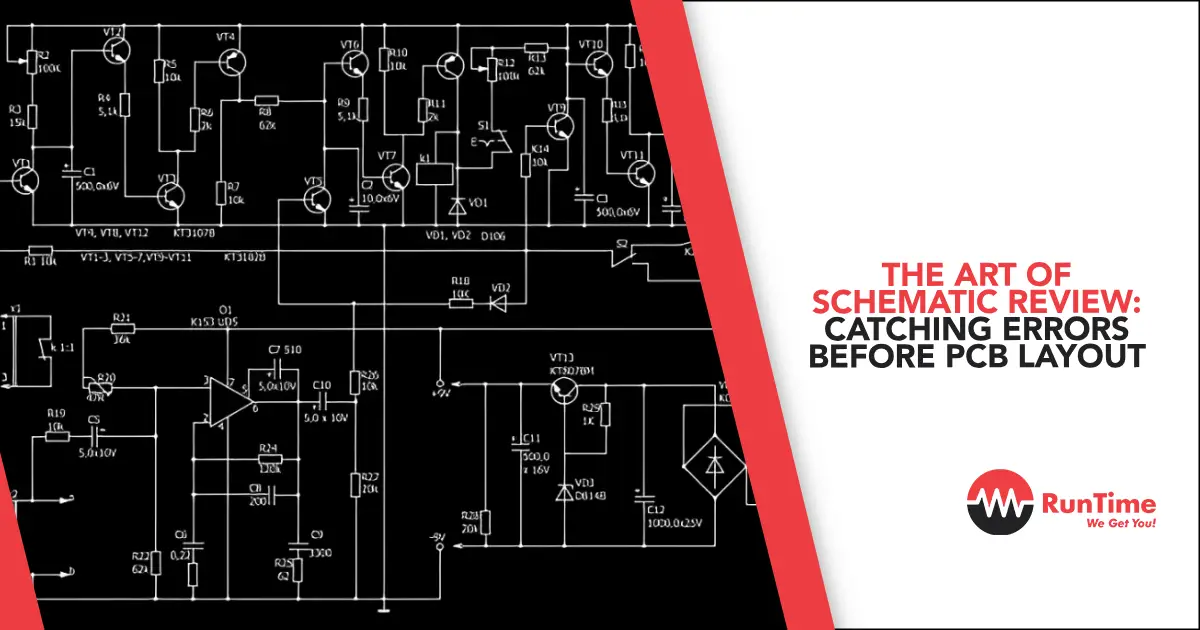Introduction
In the world of embedded systems and electronics design, the schematic is the blueprint that defines how a circuit will function. It is the foundation upon which the entire design is built, and any errors in the schematic can lead to costly and time-consuming issues during PCB layout, prototyping, and production. For embedded engineers, mastering the art of schematic review is a critical skill that can save time, money, and frustration by catching errors before they propagate into the physical design.
A thorough schematic review ensures that the circuit is not only electrically sound but also optimized for manufacturability, testability, and reliability. This article explores the importance of schematic review, outlines common errors to watch for, and provides a structured approach to conducting effective reviews. Whether you’re a seasoned engineer or a newcomer to the field, this guide will help you refine your schematic review process and improve the quality of your designs.
Why Schematic Review Matters
The Cost of Schematic Errors
Errors in a schematic can have far-reaching consequences. A simple mistake, such as an incorrect pin assignment or a missing pull-up resistor, can lead to a non-functional prototype, requiring costly PCB respins and delays in product development. In some cases, errors may not be discovered until the product is in the field, leading to recalls, warranty claims, and damage to a company’s reputation.
By catching errors during the schematic review phase, engineers can avoid these pitfalls and ensure that the design is ready for PCB layout. A well-reviewed schematic not only reduces the risk of errors but also makes the layout process smoother and more efficient.
The Role of Collaboration
Schematic review is not a solitary activity—it is a collaborative process that involves multiple stakeholders, including hardware engineers, firmware developers, PCB designers, and even manufacturing teams. Each team member brings a unique perspective to the review, helping to identify issues that might otherwise go unnoticed.
For example, a firmware developer might notice that a microcontroller’s GPIO pins are misconfigured, while a PCB designer might flag a component that is difficult to route or place. By involving all relevant parties in the review process, engineers can ensure that the schematic is optimized for all aspects of the design.
Common Schematic Errors to Watch For
To conduct an effective schematic review, it is important to be aware of the most common types of errors that can occur in a schematic. Below are some of the key issues to watch for:
1. Incorrect Pin Assignments
- Mislabeling or misconnecting pins on components, such as microcontrollers, connectors, or ICs, is a common mistake. For example, swapping the TX and RX lines on a UART interface can render the communication channel non-functional.
- How to catch it: Cross-check pin assignments against the component datasheet and reference designs.
2. Power and Ground Issues
- Missing or incorrect power and ground connections can cause a circuit to fail or behave unpredictably. This includes issues like missing decoupling capacitors, incorrect voltage levels, or insufficient current capacity.
- How to catch it: Verify that all power and ground nets are properly labeled and connected. Use a power tree diagram to ensure that all components receive the correct voltage and current.
3. Signal Integrity Problems
- Poorly designed signal paths can lead to issues such as crosstalk, reflections, and EMI. This is especially critical for high-speed signals like USB, HDMI, or DDR memory interfaces.
- How to catch it: Review signal paths for proper termination, impedance matching, and routing constraints.
4. Missing or Incorrect Pull-Up/Pull-Down Resistors
- Open-drain or open-collector outputs require pull-up or pull-down resistors to function correctly. Missing or incorrectly sized resistors can lead to floating signals and erratic behavior.
- How to catch it: Check all open-drain and open-collector outputs for proper pull-up/pull-down resistors.
5. Incorrect Component Values
- Using the wrong resistor, capacitor, or inductor value can alter the behavior of a circuit. For example, an incorrectly sized capacitor in a filter circuit can shift the cutoff frequency.
- How to catch it: Double-check all component values against the design requirements and calculations.
6. Unconnected Nets
- Floating or unconnected nets can cause unexpected behavior or leave critical functions disabled.
- How to catch it: Use the schematic capture tool’s design rule check (DRC) feature to identify unconnected nets.
7. Inconsistent Net Naming
- Inconsistent or unclear net names can make the schematic difficult to understand and troubleshoot. For example, using “VCC” in one place and “VDD” in another for the same voltage rail can cause confusion.
- How to catch it: Standardize net names and labels across the schematic.
8. Violation of Design Rules
- Every design has specific rules and constraints, such as maximum voltage ratings, current limits, or temperature ranges. Violating these rules can lead to component failure or safety hazards.
- How to catch it: Review the design against the system requirements and constraints.
A Structured Approach to Schematic Review
To ensure a thorough and effective schematic review, it is important to follow a structured approach. Below is a step-by-step guide to conducting a schematic review:
Step 1: Preparation
- Gather all relevant documentation, including the schematic, bill of materials (BOM), datasheets, and design requirements.
- Assemble a review team with representatives from hardware, firmware, PCB design, and manufacturing.
Step 2: Initial Walkthrough
- Begin with a high-level walkthrough of the schematic to understand the overall architecture and functionality.
- Identify key components, interfaces, and signal paths.
Step 3: Component-Level Review
- Verify that each component is correctly placed and connected. Cross-check pin assignments, power connections, and signal paths against the datasheet.
- Ensure that all components are available and have appropriate footprints for PCB layout.
Step 4: Power and Ground Review
- Check all power and ground connections for correctness and completeness.
- Verify that decoupling capacitors are placed close to power pins and that the power supply can deliver the required current.
Step 5: Signal Integrity Review
- Review high-speed signal paths for proper termination, impedance matching, and routing constraints.
- Check for potential sources of noise, crosstalk, or EMI.
Step 6: Design Rule Check (DRC)
- Run the schematic capture tool’s DRC feature to identify unconnected nets, duplicate nets, and other common errors.
- Address any issues flagged by the DRC.
Step 7: Cross-Functional Review
- Collaborate with firmware developers to ensure that GPIOs, peripherals, and communication interfaces are correctly configured.
- Work with PCB designers to identify components that may be difficult to route or place.
Step 8: Manufacturability Review
- Review the schematic for manufacturability, ensuring that all components are available and that the design can be assembled using standard processes.
- Check for components with special requirements, such as thermal management or ESD protection.
Step 9: Final Verification
- Perform a final walkthrough of the schematic to ensure that all issues have been addressed.
- Confirm that the schematic meets all design requirements and constraints.
Tools and Techniques for Effective Schematic Review
1. Schematic Capture Tools
- Modern schematic capture tools, such as Altium Designer, KiCad, and OrCAD, include features like design rule checking (DRC), netlist generation, and cross-probing with PCB layout tools. These features can help automate parts of the review process and catch common errors.
2. Checklists
- A schematic review checklist is a valuable tool for ensuring that no aspect of the design is overlooked. The checklist should include items such as power and ground connections, signal integrity, component values, and design rules.
3. Simulation and Analysis
- Circuit simulation tools, such as SPICE, can help validate the functionality of critical circuits before moving to PCB layout. Signal integrity analysis tools can also be used to identify potential issues with high-speed signals.
4. Peer Review
- A fresh set of eyes can often spot issues that the original designer may have missed. Peer review is an essential part of the schematic review process and should be conducted by someone with a different perspective or area of expertise.
Best Practices for Schematic Review
1. Start Early and Review Often
- Don’t wait until the schematic is “finished” to start the review process. Conduct reviews at key milestones, such as after completing a major block or interface.
2. Document Issues and Changes
- Keep a record of all issues identified during the review and the actions taken to resolve them. This documentation can be valuable for future reference and for ensuring that issues are not reintroduced.
3. Focus on Critical Areas
- Pay special attention to critical areas of the design, such as power supplies, high-speed interfaces, and safety-critical circuits.
4. Learn from Past Mistakes
- Reviewing past designs and identifying common errors can help improve the review process and prevent similar issues in future projects.
Conclusion
The art of schematic review is a vital skill for embedded engineers, enabling them to catch errors before they become costly problems. By following a structured approach, leveraging the right tools, and fostering collaboration among team members, engineers can ensure that their schematics are accurate, optimized, and ready for PCB layout.
A well-reviewed schematic not only reduces the risk of errors but also lays the foundation for a successful product. By mastering the art of schematic review, embedded engineers can deliver designs that are reliable, manufacturable, and capable of meeting the demands of today’s complex electronic systems.









